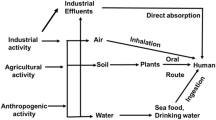Abstract
Cadmium is one of the most toxic heavy metals and is known to accumulate in freshwater food chains. The underlying mechanism for its genotoxicity has not been investigated for any freshwater fish. It has, however, been suggested that cadmium-induced carcinogenesis might involve either direct or indirect interaction of Cd2+ with DNA. The interaction between Cd2+ and DNA from the kidney of the silver crucian carp (Carassius auratus gibelio) in vitro and in vivo is investigated by spectrophotometric methods and agarose gel electrophoresis methods. Cd2+ could insert into DNA basepairs, bind to nucleic acid, and result in notable hypochromicities. The analysis of agarose gel electrophoresis, proves that Cd2+ at different concentrations does not cause DNA cleavage in vitro; however, kidneys display the classical laddering degradation of DNA in vivo, which is the result of the promotion of deoxyribonuclease activity or inhibition of superoxide dismutase and catalyse activity and the accumulation of reactive oxygen species caused by Cd2+ ions in vivo.
Similar content being viewed by others
References
D. R. Dixon and J. W. Wilson, Genetics and marine pollution, Hydrobiologia, 420, 43 (2000).
L. X. Xiang, J. Z. Shao, and Z. Meng, Apoptosis induction in fish cells under stress of six heavy metal ions, Prog. Biochem. Biophys. 28(6), 866–869 (2001) (in Chinese).
X. W. Zhou, G. N. Zhu, J. H. Sun, and M. Jilisa, The liver cellular DNA breaks and repair of the fish (caressius auratus) induced by the sublethal metal mixture, Nucl. Tech. 25(6), 408–412 (2002) (in Chinese).
Y. F. Zhu, R. H. Cui, Z. Q. Ge, F. S. Hong, and Y. X. Xu, Biological accumulation of metals in Cambarus clarkii, Reservoir Fis. 23(1), 11–12 (2003) (in Chinese).
Y. F. Zhu and Z. Q. Ge, Effects of copper and cadmium accumulation on Heavy release in Cambarus clarkii, Reservoir Fish. 24(4), 26–27 (2004) (in Chinese).
M. P. Waalkes, Cadmium carcinogenesis in review, J. Inorg. Biochem. 79, 241–244 (2002).
E. A. Hassoun and S. J. Stohs, Cadmium-induced production of superoxide anion and nitric oxide, DNA single strand breaks and lactate dehydrogenase leakage in J774A. 1. Cell cultures, Toxicology 112, 219–226 (1996).
M. Shimizu, J. F. Hochadel, and M. P. Waalkes, Effects of glutathione depletion on cadmium-induced metallothionein synthesis, cytotoxicity, and proto-oncogene expression in cultured rat myoblasts, J. Toxicol. Environ. Health 51, 609–621 (1997).
N. Asatiani, N. Sapojnikova, M. Abuladze, et al., Effects of Cr(VI) long-term and low-dose action on mammalian antioxidant enzymes (an in vitro study), J. Inorg Biochem. 98, 490–496 (2004).
A. Hartwig, Carcinogenicity of metal compounds: possible role of DNA repair inhibition, Toxicol. Lett. 103, 235–239 (1998).
Z. Hossain and F. Huq, Studies, on the interaction between Cd2+ and DNA, J. Inorg. Biochem. 90, 85–96 (2002).
D. Beyersmann and S. Hechtenberg, Cadmium, gene regulation, and cellular signalling in mammalian cells, Toxicol. Appl. Pharmacol. 144, 247–261 (1997).
H. Shimada, Y. H. Shiao, M. Shibata, and M. P. Waalkes, Cadmium suppresses apoptosis induced by chromium, J. Toxicol. Environ. Health 54(2), 159–168 (1998).
J. J. Black, E. D. Evans, J. C. Harshbarger, and R. F. Zeigel, Epizootic neoplasms in fishes from a lake polluted by copper mining wastes, J. Natl. Cancer Inst. 69, 915–926 (1982).
X. Lekube, P. M. Cajaraville, and I. Marigomez, Use of polyclonal antibodies for the detection of changes by cadmium in lysosomes of aquatic organisms, Sci. Total Environ. 247, 201–212 (2000).
B. Victor, Hispathological progression of hemic neoplasms in the tropical crab Pratelphusa hydromous (Herbst) treated with sublethal cadmium chloride, Arch. Environ. Contam. Toxicol. 25, 48–54 (1993).
D. Hoole, The effects of pollutants on the immune response of fish: implications for helminth parasites, Parassitologia 39, 219–225 (1997)
P. L. Olive, DNA damage and repair in individual cells: applications of the comet assay in radiobiology, Int. J. Radiat. Biol. 75, 395–405 (1999).
J. Zhou, M. A. Bruns, and J. M. Tiedje, DNA recovery from soils of diverse composition, Appl. Environ. Microbiol. 62, 316–322 (1996).
M. Kunitz, Crystalline deoxyribonuclease I, J. Gen. Physiol. 33, 349–362 (1950).
C. Beauchamp and I. Fridovich, Superoxide dismutase: improved assays and assay applicable to acrylamide gels, Anal. Biochem. 44, 276–286 (1971).
A. Claiborne, Catalase activity, in Handbook of Methods for Oxygen Free Radical Research, R. A. Greenwald, ed., CRC, Boca Raton, FL, (1985).
J. A. Buege and S. D. Aust, Microsomal lipid peroxidation, Methods Enzymol 52, 302–310 (1978).
O. H. Lowry, N. J. Rosebrough, A. L. Farr, and R. L. Randall, Protein measurement with the folin phenol reagent, J. Biol. Chem. 193, 265–275 (1951).
E. B. Hua and P. Yang, Studies on the interaction of Cu2+ and Cd2+ with poly(I:C), Polyhedron 15(12), 2067–2070 (1996).
E. B. Hua and P. Yang, Studies on the interaction between poly(I:C) and Cd2+, Chem. J. Chin. Univ. 17(8), 1185–1187 (1996) (in Chinese).
Mudasir, N. Yoshioka, and H. Inoue, DNA binding of iron(II) mixed-ligand complexes containing 1,10-phenanthroline and 4,7-diphenyl-1,10-phenanthroline, J. Inorg. Biochem. 77, 239–247 (1999).
M. P. Waalkes and G. Oberdorster, in Biological Effects of Heavy Metals, E. C. Foulkes, ed., CRC, Boca Raton, Fl, pp. 129–157 (1990).
Author information
Authors and Affiliations
Rights and permissions
About this article
Cite this article
Hong, F., Wu, C., Liu, C. et al. Interaction mechanism between Cd2+ ions and DNA from the kidney of the silver crucian carp. Biol Trace Elem Res 110, 33–42 (2006). https://doi.org/10.1385/BTER:110:1:33
Received:
Accepted:
Issue Date:
DOI: https://doi.org/10.1385/BTER:110:1:33




